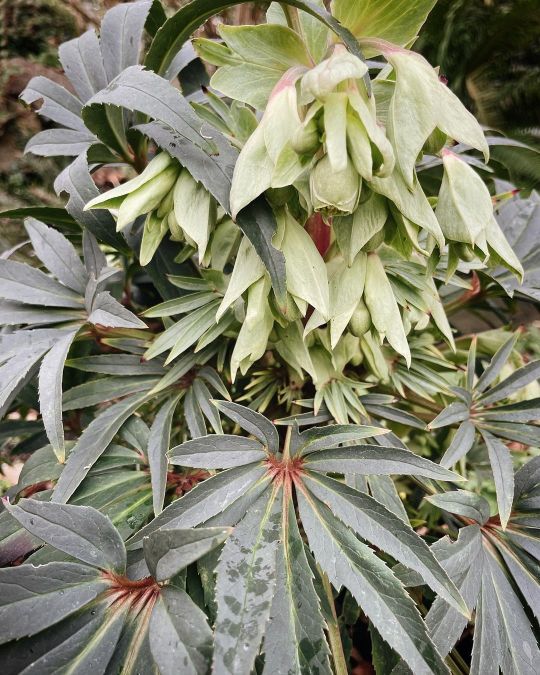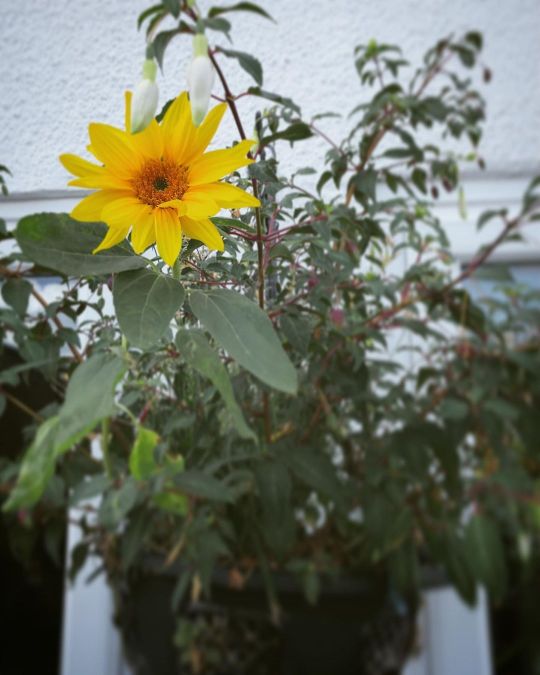#selfseeding
Explore tagged Tumblr posts
Photo

African Daisy (Osteospermum) Cape daisy, Cape marguerite, daisybushes, a tough plant native to South Africa. It is a flowering plant that belongs to the sunflower/daisy family. Asks for almost nothing and does well in full sun. Self-seeds so watch out it doesn’t go wild. Also readily strikes from a cutting. Restricted in Victoria so apparently it can be an environmental weed. #AfricanDaisy #flower #Osteospermum #CapeDaisy #daisybushes #abcmygarden #sunflower #daisy #weed #Perennial #SelfSeeding (at Belmont, New South Wales, Australia) https://www.instagram.com/p/CpPKbZyvgD1/?igshid=NGJjMDIxMWI=
#africandaisy#flower#osteospermum#capedaisy#daisybushes#abcmygarden#sunflower#daisy#weed#perennial#selfseeding
0 notes
Text
Why Is It Necessary to Cut Flowers After They Bloom?
At Bagwani Nursery, we believe that a beautiful garden requires regular care and attention. One important practice in maintaining a vibrant and healthy garden is deadheading, which involves removing spent flowers from plants. Let’s explore why deadheading is essential, its benefits, and how to do it effectively.
Why Deadheading Is Important
1. Encourages New Blooms: Many flowering plants will produce more blooms if the old ones are removed. By cutting off the spent flowers, you prevent the plant from going to seed and instead redirect its energy into producing new flowers.
2. Improves Appearance: Removing faded flowers keeps your garden looking neat and tidy. It enhances the overall aesthetics of your garden by eliminating unsightly dead blooms.
3. Prevents Disease: Spent flowers can attract pests and harbor diseases that may spread to healthy parts of the plant. By removing them, you reduce the risk of infection and maintain the health of your plants.
4. Promotes Plant Health: Deadheading helps to prevent the plant from wasting energy on seed production. This energy can be used to strengthen the plant's root system and overall health.
Benefits of Deadheading
Extended Blooming Period: Regular deadheading can extend the flowering season of many plants, ensuring continuous blooms throughout the growing season.
Increased Flower Production: By preventing seed formation, plants are encouraged to produce more flowers.
Enhanced Growth: Plants often grow more vigorously when not burdened by the energy demands of seed production.
Better Plant Structure: Removing spent flowers can help maintain a more compact and desirable plant shape.
How to Deadhead Flowers
1. Identify Spent Flowers: Look for flowers that are wilting, browning, or losing petals. These are the blooms that need to be removed.
2. Use Clean Tools: Always use clean and sharp gardening scissors or pruners to make clean cuts. This helps prevent the spread of disease.
3. Cut Back to Healthy Leaves: When deadheading, cut back to a healthy set of leaves or a lateral bud. This encourages new growth and flower production.
4. Regular Maintenance: Make deadheading a regular part of your gardening routine. Check your plants weekly and remove spent flowers as needed.
5. Dispose Properly: Collect the removed flowers and dispose of them properly. Do not leave them on the ground as they can attract pests and diseases.
Plants That Benefit From Deadheading
Annuals: Marigolds, petunias, and zinnias thrive with regular deadheading.
Perennials: Daylilies, coneflowers, and salvias benefit greatly from this practice.
Roses: Regular deadheading encourages continuous blooming and a healthier plant.
Exceptions to Deadheading
Not all plants require deadheading. Some, like wildflowers and certain selfseeding annuals, can be left to complete their natural life cycle. Additionally, plants that produce attractive seed heads, like Echinacea or ornamental grasses, may be left uncut to add winter interest to the garden.
Conclusion
Deadheading is a simple yet effective gardening practice that can significantly enhance the beauty and health of your garden. By regularly removing spent flowers, you encourage new blooms, maintain plant health, and keep your garden looking its best. While not all plants require deadheading, many benefit greatly from this practice. Make deadheading a part of your routine, and enjoy a more vibrant and flourishing garden with Bagwani Nursery.
This guide from Bagwani Nursery provides comprehensive information on the necessity and benefits of deadheading flowers, helping both novice and experienced gardeners make informed decisions for their gardens.
For any queries please contact us or visit our website.
Phone: 7252802950
Email: [email protected]
Website: bagwaninursery.com
#Nursery in Saharanpur#Plant Nursery in Saharanpur#Wholesale Plant Nursery in Saharanpur#Wholesale Plant Supplier in Saharanpur#Natural Lawn Grass Supplier in Saharanpur
0 notes
Link
#SelfSeeding #Vegetables #Herbs #Flowers #Mother #Earth #News
0 notes
Text




Plant of the Day
Wednesday 5 October 2022
At the base of this wall the clump-forming, evergreen perennial Corydalis lutea (yellow corydalis) is thriving in the shaded location. The pale green leaves form mounds of fern-like foliage with bright yellow flowers.
Jill Raggett
#corydalis#yellowcorydalis#herbaceousperennial#evergreen#selfseeding#selfsown#yellowflowers#urbanlandscape#wall#plants#writtledesign#gardens#horticulture#garden#essex#writtle
78 notes
·
View notes
Photo

A year after our first planting of these beautiful edible flowers, the nasturtiums kept on recording to the point that it developed this lovely light yellow flower. The most beautiful snacks grow from love. Thank you @mirandashafferhair for sharing and helping us plant these! ・・・ #growninhaiti #nasturtiums #selfseeding #haiti #ayiti #abundance #goingwild #organic #nogmos #nopesticides #noherbicides #agroforestry #foodforest #variety #edible #flowers #flowerpower https://www.instagram.com/p/B9ArBLwl0Aw/?igshid=141foe8gc3psp
#growninhaiti#nasturtiums#selfseeding#haiti#ayiti#abundance#goingwild#organic#nogmos#nopesticides#noherbicides#agroforestry#foodforest#variety#edible#flowers#flowerpower
6 notes
·
View notes
Text







Busy Friday
Chard explosion
Microgreen harvest
rainbow chard
#microgreens#chard#rainbow chard#baby chard#volunteering#farm at Penny lane#harvest#hard work#God bless#farmers#friends#selfseeding
0 notes
Photo

The SHOW NOTES were just posted for the GardenDC Podcast Episode 110: Self-Sowing Plants with @hollyshimizu. You can see them at: washingtongardener.blogspot.com or at our YouTube channel. #gardendc #herbchat #selfsowngarden #selfsowers #selfseeding #plants #gardening #GardeningPodcast (at Washington D.C.) https://www.instagram.com/p/Cf97wGwuy41/?igshid=NGJjMDIxMWI=
0 notes
Photo

Helleborus foetidus, Stinking Hellebore is blooming ✨✨✨ . An evergreen perennial, 24” tall, blooming from winter to spring with clusters of “fragrant” yellowish-green weeping flowers. They prefer a rich, well-drained soil in a semi-shady location. . . . #helleborus #helleborusfoetidus #hellebore #hellebores #stinkinghellebore #shadegarden #shadegardens #shadegardening #shadegardenplants #winterinterest #evergreen #evergreenperennial #perennial #perennials #perennialgarden #perennialgardens #perennialflowers #selfseeding #droughttolerant #droughttolerantplants #woodlandgarden #woodlandgardens #woodlandgardening #woodlandplants #woodlandplanting (at Seattle, Washington) https://www.instagram.com/p/CYUD_V-FiPj/?utm_medium=tumblr
#helleborus#helleborusfoetidus#hellebore#hellebores#stinkinghellebore#shadegarden#shadegardens#shadegardening#shadegardenplants#winterinterest#evergreen#evergreenperennial#perennial#perennials#perennialgarden#perennialgardens#perennialflowers#selfseeding#droughttolerant#droughttolerantplants#woodlandgarden#woodlandgardens#woodlandgardening#woodlandplants#woodlandplanting
0 notes
Photo

Love coming home and seeing how the garden has changed. What has grown and what is seeding, closing its cycle. The coriander is seeding wildly. Love that it self seeds making my gardening a little easier #coriander #selfseeding #urbanpermaculture #kitchengarden #permacultura #upcycling #rustic #bees (at Mullumbimby) https://www.instagram.com/p/BnzXzy5n8wa/?utm_source=ig_tumblr_share&igshid=7787es5e2tux
1 note
·
View note
Photo

The sunflower 🌻 that decided to seed itself in the fuschia hanging basket; I do believe it’s living it’s best life 😂 #sunflower #sunflowersunday #yellow #flowerselfie #nature #selfseeded #hangingbasket #enjoynature #optoutside #happy #loveflowers #ff #instagood #instaflower https://www.instagram.com/p/CTt-esYD3OX/?utm_medium=tumblr
#sunflower#sunflowersunday#yellow#flowerselfie#nature#selfseeded#hangingbasket#enjoynature#optoutside#happy#loveflowers#ff#instagood#instaflower
3 notes
·
View notes
Photo

#first #people #indigenous #inspiration #buzybee #beemedicine #selfseeding #wildedaxa #plantmedicine #pollinator #orangeflower #attractir #winterbee #socialactivist #storyteller https://www.instagram.com/p/BwkEgYaBXj1/?utm_source=ig_tumblr_share&igshid=1ae1plfjgn4c5
#first#people#indigenous#inspiration#buzybee#beemedicine#selfseeding#wildedaxa#plantmedicine#pollinator#orangeflower#attractir#winterbee#socialactivist#storyteller
0 notes
Photo

Daisy or Capeweed (Arctotheca calendula) is a plant in the sunflower family commonly known as capeweed, plain treasureflower, cape dandelion, or cape marigold because it originates from the Cape Province in South Africa. It is also found in neighboring KwaZulu-Natal. Around Gunnedah and probably the whole of the west there are patches of daisies. It’s a weed but it’s also pretty. It’s a good bee plant which the poor bees need with the Verona Mite scare. No need to propagate it. It’s a weed! Did you make daisy chains as a kid? #capeweed #flower #ArctothecaCalendula #CapeMarigold #CapeDandelion #abcmygarden #sunflower #daisy #weed #annual #SelfSeeding #daisychain (at Gunnedah Show Society) https://www.instagram.com/p/CiFBwqgOQRO/?igshid=NGJjMDIxMWI=
#capeweed#flower#arctothecacalendula#capemarigold#capedandelion#abcmygarden#sunflower#daisy#weed#annual#selfseeding#daisychain
0 notes
Link
Everyone loves annuals because they’re flashy and they fill in flower bed space, giving you color and visual interest all summer. But wouldn’t it be great if you could get those advantages along with a plant that comes back year after year? You can if you select annuals that re-seed themselves. Here are the top 10 self-seeding annual plants:
0 notes
Photo

Future nasturtiums. #selfseeding #nasturtium #TheDirtOnOrganicGardening
2 notes
·
View notes
Photo

Centranthus ruber is one of the few plants that always finds the perfect spot to self-seed. Softening hardscape and integrating beautifully with human habitation. . #centranthus #centranthusruber #beach #coast #landscape #sea #bench #redvalerian #hardscape #plants #foliage #flower #selfseeded (at Pevensey Bay) https://www.instagram.com/p/CCKCBkiA29g/?igshid=1nvc752nsbdde
#centranthus#centranthusruber#beach#coast#landscape#sea#bench#redvalerian#hardscape#plants#foliage#flower#selfseeded
4 notes
·
View notes
Photo

I find it quite funny how I’ve never trellised anything I’ve purposely planted but I happily protect those growing wild 😅 ・・・ #growninhaiti #tomatoes #selfseeding #haiti #ayiti #wild #nogmos #nopesticides #noheebicides #foodforest #agroforestry #foraging #growth #organic #abundance #balance https://www.instagram.com/p/CA47IJJlJTJ/?igshid=qxzq2nd1zlqd
#growninhaiti#tomatoes#selfseeding#haiti#ayiti#wild#nogmos#nopesticides#noheebicides#foodforest#agroforestry#foraging#growth#organic#abundance#balance
2 notes
·
View notes